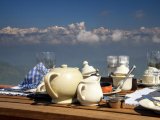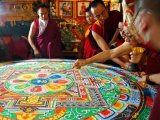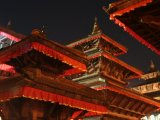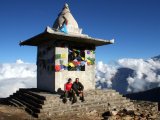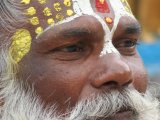Nepal is a multi-cultural, multi-linguistic and multi religious country. It has a diverse landscape, ranging from the humid Terai plains in the south to the mountainous Himalayas in the north, which contain eight of world’s 10 highest peaks and makes it a major tourist destination. Travelers to Nepal admire the "roof of the world" from a Himalayan viewpoint, strolling through the temple-lined medieval city squares of Kathmandu, Patan and Bhaktapur, and joining Buddhist pilgrims on a spiritual stroll around the centuries-old stupas and temples that lie scattered across the Kathmandu Valley. Other, more adventures will admit that, nowhere else can you trek for days or even weeks in incredible mountain scenery, knowing that a cozy lodge and hot meal await you at the end of the day. Some are drawn to Nepal by the adrenaline rush of rafting down a roaring Nepali river or bungee jumping into a bottomless Himalayan gorge. No matter the activity they all offer a rush against the backdrop of some of the world’s most dramatic landscapes. It is a true paradise for all.
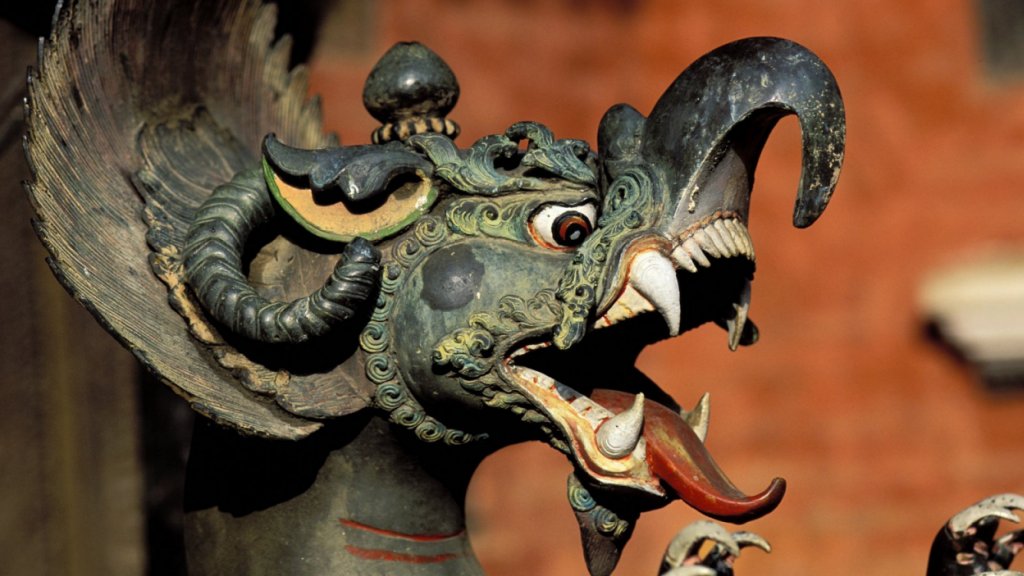
Nepal
General Information
Size (land area): 143,351 sq km = 55,348 sq mi; slightly larger than Arkansas
Population: 29,890,686
Border countries: China & India
Elevation: lowest point: Kanchan Kalan 70 m; highest point: Mount Everest 8,850 m = 29035 feet above sea level, (highest point in Asia & the tallest peak in the world)
Religion: Hindu 80.6%, Buddhist 10.7%, Muslim 4.2%, Kirant 3.6%, other 0.9%
Language: The official language is Nepali and the state currency is the Nepalese Rupee (NPR).
Flag: Nepal's flag is the only national flag in the world that is non-quadrilateral in shape. The blue border on the flag of Nepal signifies peace, red stands for victory in war or courage. It is also color of the rhododendron, the national flower of Nepal. While the curved moon is symbol of peace and calm nature of Nepalese, the sun represents the aggressiveness of Nepalese warriors.
Customs:
Nepal is rich in culture. Its culture consists of the social customs and traditions that have evolved over the centuries. This multi-dimensional cultural heritage encompasses various ethnic, tribal, social groups inhabiting different altitudes, and it manifests in different forms: music, dance, arts and crafts; folklore and folktales; languages and literature; philosophy and religion; festivals and celebration; foods and drinks.
Food:
Nepal does not have a distinct cooking style. However, food habits differ depending on the region. Nepali food has been influenced by Indian and Tibetan styles of cooking. Authentic Nepali taste is found in Newari and Thakai cuisines. Most Nepalese do not use cutlery but eat with their right hand. The regular Nepali meal is dal (lentil soup), bhat (boiled rice) and tarkari (curried vegetables), often accompanied by achar (pickle). Curried meat is very popular, but is saved for special occasions, as it is relatively more expensive. Momos (steamed or fried dumplings) deserve a mention as one of the most popular snack among Nepalese. Rotis (flat bread) and dhedo (boiled flour) also make meals in some homes.
Wildlife:
Nepal’s 20 protected areas cover 23% of its land. Its 10 national parks, three wildlife reserves, six conservations areas and one hunting reserve cover various geographical locations from the sub-tropical Terai jungles to the arctic Himalayan region. Two of Nepal’s natural areas are listed by UNESCO as Natural World Heritage Sites. They are: Chitwan National Park and Sagarmatha National Park.
From the “Lonely Planet”:
“The steamy jungles of southern Nepal are home some of the best wildlife watching in Asia, if not the world. Within the Terai plains, visitors can seek out tigers, elephants, monkeys, rhinos, bears, deer, crocodiles, leopards, river dolphins and a staggering 867 species of birds.
The world-heritage listed Chitwan National Park is regarded as Nepal’s most popular national park, both for its abundance of animals and its accessibility to Kathmandu. Bardia National Park is much more remote and also more pristine. Just getting around the parks is an adventure, usually involving a mix of elephant safaris, rafting, jungle walks and jeep trips. While poaching took its toll on animal numbers during the decade-long Maoist insurgency, the latest counts show numbers to be on the incline.
Visitors to Africa often want to tick off the Big Five (lion, elephant, rhino, leopard and buffalo), and if you swap tigers for lions, you can do the same in Nepal. One of the most majestic animals in the world, the Royal Bengal tiger is also one of the hardest to spot. The density of their habitat combined with the foliage’s orange-brown hues keep these notoriously shy cats well camouflaged.
Living in stealth across the Terai, the spotted leopard is Nepal’s other elusive big cat. Keep your eyes peeled above – most sightings occur in the limbs of trees.
The greater one-horned rhino, with armour-like body plates and a solitary horn similar to its African brethren, is Nepal’s local celebrity. The most common way to spy a rhino is by riding on the back of an elephant, effortlessly traversing the park’s jungle vegetation from an excellent vantage point. An option for braver souls is to track the rhino on a jungle walk. Test your tree-climbing skills before setting out, as rhinos have been known to occasionally charge tourists. All lodges in the park can arrange guides for jungle treks.
Bardia National Park is the place to see wild elephants, where you have a good chance of spotting them along the banks of the Karnali River. Otherwise you can settle for getting intimate with the park’s domestic elephants, lending a hand with their daily wash in the river at Chitwan.
Buffalo round out the last of the Big Five, and Nepal is home to one of the last remaining habitats of arna — an endangered species of long-horned wild buffalo. You will find a healthy population grazing each evening along the wetlands of the Koshi Tappu Wildlife Reserve in eastern Terai.
However, not all of Nepal’s wildlife is found in the jungles. The most famous Himalayan inhabitant is the snow leopard. With its thick, white spotted fur, it is undoubtedly one of the world’s most beautiful cats, and also one of the most elusive. A less expected high-altitude animal is the red (lesser) panda, which can be found in the foothills of eastern Nepal. Other wildlife to watch for include the Himalayan tahr (mountain goat), bharal (Himalayan blue sheep) and everyone’s favorite shaggy bovine, the yak.”
Currency and Foreign Exchange:
Nepali Rupee notes come in Rs. 1, 2, 5, 10, 20, 25, 50, 100, 500, 1000 denominations. Coins come 5p, 10p, 25p, Rs. 1, 2, 5 denominations. Foreign currencies must be exchanged only through the banks or authorized foreign exchange dealers. The receipts from such transaction are to be obtained and retained. Visitors can exchange foreign currency at the foreign exchange counter at the airport upon arrival. Visitors other than the Indian national have to make the payment in foreign currency in hotel, travel agencies or trekking agencies and air tickets. Non-Indian visitors are not allowed to import or export Indian currency. The approximate value of one USA dollar is equivalent to Rs. 86 as of March 2013.
Entry Requirements:
All visitors except the Indian nationals must hold a passport and a valid visa. The visas can be obtained at the Nepalese Diplomatic Missions and Consulates abroad and entry points issue visa for visitors. For information and assistance with the obtaining of a visitor visa to Nepal, please click on the following link.
When to Travel?
Climate factors are very important in deciding on a visit to Nepal. October-November, the start of the dry season, is in many ways the best time of the year in Nepal. With the monsoon only recently finished the country-side is green and lush and Nepal is at its most beautiful. Rice is harvested and there are some more important and colorful festivals to enjoy. At this time of the year the air is sparkling clean, visibility is unexcelled and the Himalayan views are as near perfect as you can ask. Furthermore the weather is still balmy, neither too hot nor too cold. For obvious reasons, this is also the peak tourist season.
In December-January the temperatures and visibility are still good, though it can get very cold. There's sometimes a brief winter monsoon, lasting just a day or two in January.
February-March-April, the tail end of the dry season, is good second-best time. The weather gets warmer so high-altitude treks are no longer as arduous, although by the end of the dry season, before the monsoon breaks, it starts to get too hot for comfort. Visibility is not good as earlier in the dry season since the country is now very dry, and dust in the air reduces that crystal Himalayan clarity. In compensation, Nepal's wonderful rhododendrons and many other flowers are in bloom so there's plenty of color to be seen along the roads and trails.
May and the early part of June are not the best months as it is extremely hot and dusty and the coming monsoon hangs over you like a threat. Mid-June to September, when the monsoon finally arrives, is the least popular time to visit Nepal. The rains wash the dust out the air, but the clouds obscure the mountains so you're unlikely to enjoy more than a rare glimpse of Himalaya.
Travel Highlights
Very few countries in the World can offer as many varieties of adventure tourism packages as Nepal. Of the 14 peaks above 8000 meters in the World, eight are located in Nepal. It is the land of Sagarmatha (Mount. Everest 8848 meters), the highest peak in the World and other 1310 mountain peaks which are opened for expeditions. Nepal has thousands of such peaks, which are yet to be conquered by the expeditions. For those who cannot withstand the rigorousness mountain climbing there are mountain flights, which fly around the Mt. Everest and provide a close look of the top of the World. From Nagarkot (32 kilometers East of Kathmandu) and Daman (80 Kilometer southwest of Kathmandu) one can have a distant view of Mt. Everest and beautiful Himalayan range. Trekking is the best way to get to interesting and remote mountain villages of Nepal and to enjoy views of the focused peaks together with their lifestyle untouched by modern civilization.
The river rafting which is known as White Water Adventure represents another major attractions. With distance of 100 miles, one can see the topographical variations with the river rising from the higher points near Nepal - Tibetan border and then dropping dramatically to lower levels the plains bordering India. For those who wish to view wildlife, Nepal offers plenty of scope. There are eight National Parks and four Wildlife Reserves and two Conservation Area in Nepal.
For the less adventure, Pokhara the lake-city of Nepal has no equal as it provides ample opportunities for fishing, swimming, canoeing and boating along with the sightseeing of majestic panoramic views in its background. It is only Pokhara, a tropical spotty with an altitude of about 900 meter from where one can see the mountain crossing over 8000 meters from such a short distance of about 40 kilometers. For the nature lovers Nepal is such a land of natural beauty that metaphors cannot delineate its real picture.
At the same time, Nepal proffers an incomparable scope to the scholars and connoisseurs of art and culture to see and study the different aspects of fine arts be it painting, sculpture, woodcarving or architecture.Kathmandu valley possesses several historical monuments, old place and palace squares, shrines and temples. Ageless tradition and legends all make it a living museum that any visitor would cherish its vivid memory in his/her heart forever.
Nepal is the land of Lord Pashupatinath, which is the holiest Hindu temple in the World. Besides, two out of the four main holy places (Chhetras) of Hindu pilgrimages namely Muktichhetra and Varahachhetra, are located in Nepal. Not only for the Hindus but also for the Buddhists, Nepal offers a unique place of pilgrimage as it happens to be the birthplace of Lord Buddha, the apostle of peace and compassion. Nepal is the Land of festivals with some part of the Kingdom or the other celebrating festival everyday of the year. Festivals may be linked with the remembrance of the departed soul, to herald the different seasons, to mark the beginning or end of the agricultural cycle, to mark the national events, or just family celebrations. On a festive day the Nepalese take their ritual bath, worship different gods and goddesses, visit temple, observe fasting and undertake feasting. The most important aspect of Nepalese culture is the religious harmony and understanding prevailing among the Hindus and Buddhist. Some of the major festivals of Nepal are:
Highlights:
Kathmadu City
Kathmandu is known as Kantipur, the kingdom of Nepal. Here you will visit the temple of the living Goddess, who acknowledges the greetings of her devotees from balcony of her temple residence, Kathmandap-the source of the name Kathmandu. It was allegedly made from the timber of a single tree. Next, on to the Durbar Square area with its array of temples overlooked by the Hanuman Dhoka Palace, the ancient palace of the Nepalese Royalty.
Pashupatinath
Lying 6 Km from central Kathmandu, Pashupatinath temple is one of the holiest Hindu temples dedicated to Lord Shiva. Situated amidst a lush green natural setting on the bank of the sacred Bagmati river, the temple, which was built in pagoda style, has a gilded roof and beautifully carved silver doors. Visitors will be permitted to view the temple from the east bank of the Bagmati river, as entrance into the temple is strictly forbidden to all non-Hindus. Pashupatinath is the centre of an annual pilgrimage on the day Shivaratri, which falls in February or March. Behind the temples are the cremation grounds.
Dakshinkali
Literally meaning the Kali of the south, this temple is dedicated to the Goddess Kali, the Hindu goddess of power. Goats, chickens, ducks etc. are sacrificed on Tuesdays and Saturdays. The temple itself is located in a forested canyon and lies 19 Km. from Kathmandu.
Boudanath
This stupa, situated 11 Km. from the center of Kathmandu, is one of the biggest in the world of its kind. It stands with four pairs of eyes in the four cardinal directions, keeping a lookout for righteous behavior and human prosperity. This Buddhist stupa was built by King Man Deva at the advice of the Goddess Mani Jogini. It is built on an octagonal base and is contains inset prayer wheels. The shrine is surrounded by the homes of Lamas, or Buddhist priests.
Swayambhunath
Located approximately 3km from the center of Kathmandu, this Buddist stupa is said to be 2000 years old. The stupa which forms the main structure is composed of a solid hemisphere of brick and earth which supports a lofty conical spire capped by a pinnacle of gilt copper.
Painted on the four sided base below the spire are the all seeing eyes of lord Buddha. The whole area around the Stupa contains an array of small stupas and temples. This is one of the best places from which to view the Kathmandu valley, as it is situated an a small hillock.
Bhaktapur
Also known as BHADGAON meaning the city of devotes, this place is the home of medieval art and architecture. Lying 14Km east of kathmandu city. This place was founded in the 9th century and is shaped like a conch shell. The city is at the height of 4600 ft. Above sea level. In Bhaktapur you will visit the Durbar Square with its array of temples overlooked by the palace of 55 Windows built by King Bupatindra Malla, the Nytapola Teple. This temple, which was also built by king Bhupatindra Malla, is the best example of the Pagoda style and stands on five terraces, on each of which stands a pair of figures, famous strong men, elephants, lions, griffins and goddesses. Time permitting, a visit to the museum of Thanka painting can also be considered. A 30 minute walk brings you to the Dattatraya temple and Pujari Math which can also be done provided there is plenty of time at the clients' disposal.
Nagarkot
It is situated about 35Km. east of Kathmandu city and from here one can see Mt. Everet and other peaks of the Himalayas. Nagarkot is located between Kathmandu valley in the west and Indravati in the east.
The top of Nagarkot commmands accelerating views in all direction. The altitude of Nagarkot is 2229Mt. Above from sea level. It is also very popular for the viewing sunrise and sunset.
Dhulikhel
It is situated at an altitude of 1600 m. above from sea level and 32 Km. From Kathmandu City. Dhulikhel is famous for its vantage location in viewing the Himalayan ranges, from Cho Oyu in the east to Himalchuli in the west. It is popular for viewing the sunrise and sunset.
Patan
5 Km. away from Kathmandu city. Patan, also known as Lalitpur, is a city of fine arts, enclosed within 4 stupas, which are said to have been built in the 3rd century A.D. by Emperor Ashoka.
You will see Durbar square, the Patan durbar (palace), which houses a bronze collection, the Krishna temple built by King Siddi Narsinh Malla, Hiranya Varna Mahavihar, and Mahaboudha Temple.
A trip to the Tibetan Refugee Centre and the Handicraft Centre will be included during your visit to Patan, where you will witness the hand weaving of Tibetan carpets and molding of metal statues.
Pokhara Valley
Pokhara is Nepal's second most popular tourist destination and its adventure capital. It is overshadowed by a massive wall of the Himalayas, and dominated by the towering peak of the Annapurna range. Even more impressive is the fishtailed pinnacle of Mt. Machhapuchhare (6977 mt.) For the adventurous, the massif of Mt. Dhaulagiri (8167m) waits to be explored. Pokhara is the starting point for the most famous treks in Nepal, in the Annapurna area. Pokara is situated 200 K.M. west of Kathmandu.
Suggested Journeys
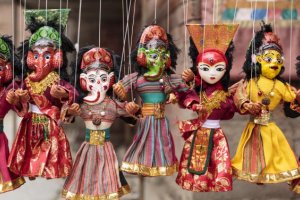 Treasures of India & Nepal: A Cultural Adventure
Treasures of India & Nepal: A Cultural Adventure10 Days / 9 Nights • Daily Arrival in Delhi, year-round
Delve into the beauty of India and Nepal while connecting with friendly people along the way. From iconic attractions like the Taj Mahal to colorful markets tucked amid bustling city streets, this 10-day tour is for those who crave both cultural adventure and fine comfort.
A Journey by Private Car and Guide, featuring Delhi, Kathmandu, Chitwan, Pokhara, Agra (Taj Mahal) & Jaipur
Featured Properties
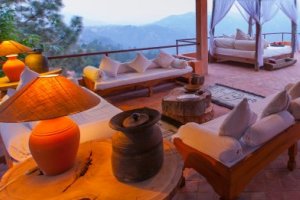 The Dwarika's Resort, Dhulikhel
The Dwarika's Resort, DhulikhelConnect with the beauty of Nepal’s Kathmandu Valley while enjoying spiritual-inspired luxury at this unique resort. Spa treatments, yoga classes and decadent cuisine combine to provide an experience that captures the essence of the Himalayans.
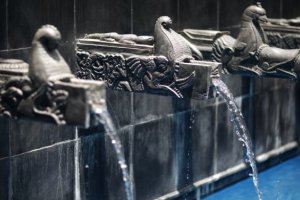 Dwarika’s Hotel, Kathmandu
Dwarika’s Hotel, KathmanduA tranquil retreat in bustling Kathmandu, the Dwarika’s Hotel melds Old World tradition with divine luxury. Perfectly located near the center of the city, this is the ideal base to explore attractions while embracing traditional culture.
